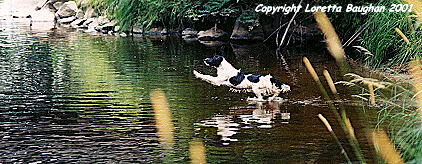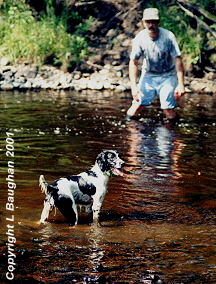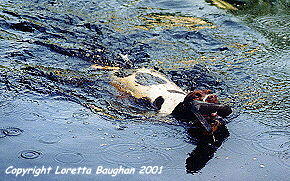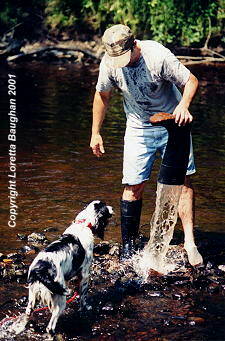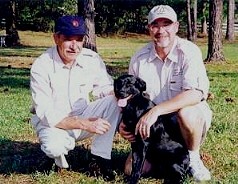or the wildfowler as well as the upland hunter who shoots over land that includes lakes and rivers, a good water dog is essential.
Although most dogs love water once they have discovered the enjoyment of swimming, many encounter problems in water - or can be difficult to control once they are in it - unless trained correctly. Running water, waves, rushes and reeds, heavy mud and obstructions in the water itself can create all kinds of difficulties. A big problem we have as handlers is that if our dog does get into difficulties or decides not to pay attention, then there is no way we can get out there to help or to enforce controls. Therefore, we have to ensure that before we try to control and handle in water, our land work and training is pretty good.
I usually find that the dogs are ready for serious water training at between ten to eighteen months. By that time, I have done quite a bit of obedience and standard gundog training on land and feel confident that I can control most simple situations that may occur in water. However, with pups born in the spring or early summer I like to take them to water when they are about three or four months old - just to introduce them and have fun.
If I have two of them, it is even better as they encourage each other and if I paddle in the shallows they usually follow and run with each other so that any concerns disappear. Where I have only one pup an older dog can help but I only take one that is calm and gentle with the pup as the last thing I want is a big boisterous fellow frightening the pup by knocking him about and jumping on him while in the water. Pups that have played in water and enjoy retrieving on land are generally easy to introduce to water
Many times, I encourage a pup into water by just letting it run through shallow streams or puddles. A short retrieve over a shallow stream quickly builds confidence.
Often, it is the first entry into water where a pup goes out of its depth that is the breaking point. If a pup goes into the water very fast and suddenly finds himself out of its depth, he can easily frighten himself. One fright of this nature can make water introduction a long a frustrating business. One mistake. One loss of temper. One unfortunate mishap - and you may be struggling for a long timeÖ maybe even a lifetime.
A dog that jumps into deep water and finds himself very wet and submerged can become frightened and panic. So the first stages are small and careful Ė just in case.
If possible, find a place free of distractions and where you can drive down to waters edge to take your dog in and out of the car easily. I like to find a gentle sloping entry into a still, clean pond for the first real swim. Firm and sandy if possible, free of obstructions and definitely not muddy. One where you can walk in up to your knees, if required. A place where the bank does not suddenly drop and the pup is out of its depth.
Initially, I will give a pup a couple of retrieves along the bank to create enthusiasm. Then I throw a retrieve into the water - but at a very fine angle to the bank and just in the water, about five or six yards away. In this way, the pup runs along the shore and then only a short distance into the water. The impetus of running on the bank takes the pup into the water before he realizes.
All the time, I make it fun and enjoyable.
At each throw, the dummy falls further and further out into the water until the pup is beginning to swim just a short distance. When this happens, I then increase the angle into the water until I am throwing the dummy directly out into the water and sending the pup for the retrieve. Always short, always fun and always watching my dog to ensure there is no concern that means we should not make it more complex until we have mastered what we have already done with confidence. Donít try to do too much too soon.
Personally, I have never found the need for a lead to walk them through the shallows or to carry them although some trainers advocate this. Some even take a dog out in a boat and lower him over the side but again I have never had to resort to this and would not advise it as it can easily frighten a dog.
In most cases, make sure your dog is steady on land before giving retrieves in water otherwise he will quickly learn that you cannot get to him once he is swimming. However, in these initial stages, with a dog that is a little nervous of water, it is more important to get him confidently swimming. With this type of dog it can be advantageous to increase enthusiasm by letting him run in to the throw. Once you have your dog confidently swimming on the simple retrieves, steady him again on land and insist on it next time on water.
Nice hot sunny days are the best for water training and although we recommend never training in the heat of the day, this is one piece of training where the rule can be broken. There is nothing nicer for you or your dog than to go swimming on those rare hot summer days. The worst thing you can do is to try to get a novice dog swimming when it is cold. But in summer, when it is hot, that is different. Once a dog has swam and been retrieving regularly from water on warm days, as he matures, the cold is usually no problem. But initially make it a comfortable experience.
|
"There is no doubt that once a dog has been introduced and trained correctly in water, he will love the work."
|
|
Although I like to use tennis balls a lot on land, I use dummies on water - either the standard type or smaller puppy dummies. A ball can easily be pushed to the back of the mouth as the dog is swimming and that together with the water can make breathing difficult and uncomfortable. Swimming while carrying a dummy can make your dog snort and even whistle as he swims back with a retrieve in his mouth, but this is nothing to worry about.
Many youngsters on the first outing will also splash a lot with their front legs like a Mississippi paddleboat. Itís almost as though they have forgotten they have back legs and are trying to keep their head as far out of the water as possible. If this happens, then a standard one pound dummy helps as the weight of a dummy in their mouth seems to balance them more with the front coming down and the back raising into a more comfortable swimming style.
Once I have the pup entering at a right angle to the water, I position myself close to the waters edge - sometimes even going into the water to take the retrieve. In this way, you minimize the opportunity for the dog to shake or drop the dummy on the way out. This is an important part of a good water retrieve and delivery as in the future if a duck is wounded the last thing you want is for your dog to put it down upon which it returns to the lake. Each time I am successful at getting a good retrieve to hand, I work back away from the bank until I can be as far away from it as practical.
I donít want a dog to drop a bird or shake with it so I build up the distance gradually and encourage the dog to bring the retrieve up immediately and not shake until it has delivered and I command it to. This can take a few water sessions to achieve. Don't make a big issue if the dog puts the retrieve down when it reaches land but continue working on encouraging it to come right up to you without shaking or dropping the dummy. Sometimes you may take too big a step away from the edge of the water and the dog begins to put the dummy down. Donít panic. Encourage him up to you then retrace some of your training and build it up, again. I often find that the best way to achieve this on a water retrieve, in addition to building the distance up gradually, is to give a recall whistle the moment the dog puts his mouth towards the dummy and then keep quiet until its feet touch the ground again while still in the water. I then enthusiastically encourage him up to me using whistle and voice. I also use my voice to warn against dropping or shaking if he is seen to be considering this. A quick recall and prompt return to you on land is an essential part of pre-water training if you want to get a good retrieve from water.
There is no doubt that once a dog has been introduced and trained correctly in water, he will love the work.
Anyone who goes duck shooting must train their dog to handle all kinds of water retrieves - and sometimes I think it should be called "mud retrieves". Sticky estuary mud, heavy water lilies, overgrown ponds where birds fall out of sight are all situations your dog needs to be trained for and not only in daylight but also in failing light so that it can learn to mark with its ears as well as itís eyes.
There is something special about good water work that comes from the difficulties involved with it. A good dog is essential in many instances when shooting over water, without one some game would be almost impossible to retrieve.
Nothing conjures up more magic pictures than a wildfowler and his dog crouched among the rushes on a cold and frosty morning, both of them oblivious to the light clouds of steam issuing from their mouths as they strain their eyes and ears into the distance to catch the first sight of the reason they spent many hours training and preparing for. The early morning flight.

